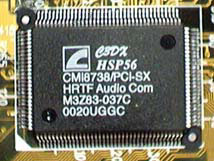Iwill WO2-R Socket 370 i815E + RAID ATX
by Henry Kuo on November 7, 2000 1:04 AM EST- Posted in
- Motherboards
The Features
Like most i815/i815E motherboards, the WO2-R has three DIMM slots, supporting a maximum of 512MB SDRAM. To most users, 512MB memory is more than enough for now, but this certainly won't be the case forever. Further, a decent server or workstation currently still requires 1GB or more memory, so 512MB is definitely not enough. This is not a fault of Iwill though; but rather is a limitation of the i815/i815E chipsets. Further, the i815/i815E chipsets also have some constraints on memory types. If you want to use PC133 SDRAM, only the first two DIMM slots can be populated. If users want to use all three DIMM slots, the memory will have to run in PC100 mode. If you don't feel like following the specifications put forth by Intel, the WO2-R does allow you to run all modules in PC133 mode, but the system became quite unstable in our testing with this option enabled. So far the ASUS CUSL2 is the only i815E solution that we have tested that can run all three DIMMs in PC133 mode without sacrificing stability.
As mentioned previously, the 82801BA ICH2 features a second USB controller and the Intel 82559 network controller. The second USB controller allows two more USB devices on top of the original two. The original USB connectors are located at the back of the I/O panel, and Iwill puts the extra two USB headers on the left hand side of the motherboard. However, Iwill does not include the necessary USB bracket to take advantage of those extra USB ports, so you will have to get their own expansion bracket or a USB hub if you want to connect more than two USB devices.
Unlike most i815/i815E boards, the WO2-R only features 5 PCI slots as part of its 5/0/1/1 (PCI/ISA/CNR/AGP) expansion slot setup. Most of the i815/i815E ATX boards we have dealt with equip with 6 PCI slots. Although there may not be a lot of users with more than five PCI devices, but more expansion never hurts. In this case, Iwill effectively used up one of those PCI slots by integrated the PCI-based AMI IDE RAID controller on the motherboard.
The CNR slot is shared with the fifth PCI slot and provides access to the 82559 network controller integrated in the 82810BA ICH2. The integrated network controller supports 10Mbps Home PNA 2.0 or 10/100 Ethernet depending on the CNR card that is plugged in. However, currently we only see a handful of suppliers of CNR cards, which is unfortunate because the 82559 network controller is quite good and the CNR cards are relatively cheap.
 Iwill
uses the C-media CMI-8738 3D 4.1 PCI sound controller for onboard sound support,
which has a much better sound quality than the usual AC97 CODEC found on most
i815E boards. The controller supports a 4.1 speaker setup (front/rear + subwoofer)
and it uses a technology from CRL 3D Audio, the 32-voice HRTF-base 3D positional
audio, which helps to position sound sources when using 4.1 speaker systems.
This technology supports Microsoft Direct Sound 3D and Aureal's A3D interfaces,
so games and applications software that utilize these interfaces will be able
to take advantage of the HRTF 3D positional audio. For example when playing
a game with A3D support, sounds that physically occur behind your character
in the game will be produced more prominently from your rear speakers in a 4.1
setup.
Iwill
uses the C-media CMI-8738 3D 4.1 PCI sound controller for onboard sound support,
which has a much better sound quality than the usual AC97 CODEC found on most
i815E boards. The controller supports a 4.1 speaker setup (front/rear + subwoofer)
and it uses a technology from CRL 3D Audio, the 32-voice HRTF-base 3D positional
audio, which helps to position sound sources when using 4.1 speaker systems.
This technology supports Microsoft Direct Sound 3D and Aureal's A3D interfaces,
so games and applications software that utilize these interfaces will be able
to take advantage of the HRTF 3D positional audio. For example when playing
a game with A3D support, sounds that physically occur behind your character
in the game will be produced more prominently from your rear speakers in a 4.1
setup.
One interesting feature of the WO2-R is the PhoenixNet support by Phoenix Technologies and AwardBIOS. The PhoenixNet Internet Launch System (ILS) is built into the BIOS firmware, and it will be installed together with your first install of Windows 98. Users can then use the program to connect to the Internet and log on to PhoenixNet free service. This can be useful for users who need guidance on the Internet, but for advanced users this might not be as useful. Moreover, since this software resides inside the BIOS, size limitations prevent the software from being used in operating systems other than Windows 98.
Bundled with the WO2-R is a CD containing all the drivers and utilities, including all the software required for the C-Media onboard sound. From the documentation perspective, the 162-page manual is excellent. It contains all the information and diagrams regarding all jumpers and connectors, and has detail descriptions on every setting in the BIOS and regarding PhoenixNet. It also explains how to properly set up a RAID array , as well as the utilities needed for the C-Media onboard sound.










0 Comments
View All Comments